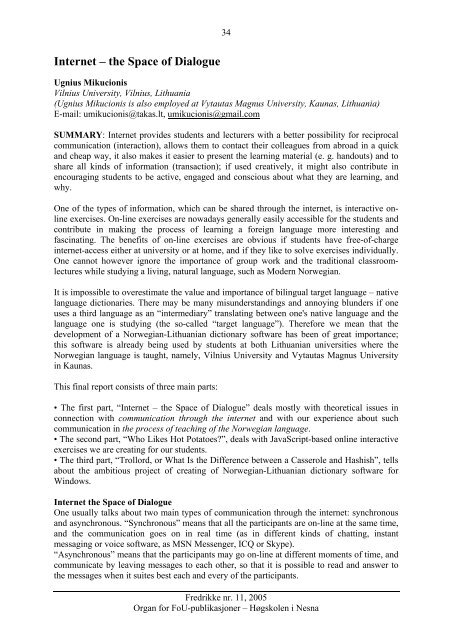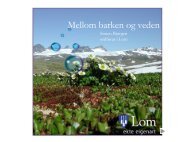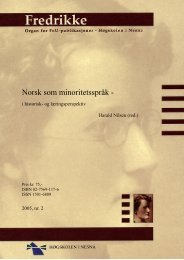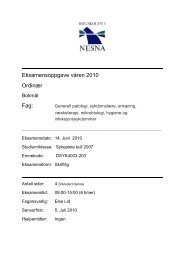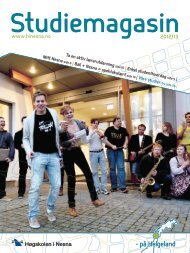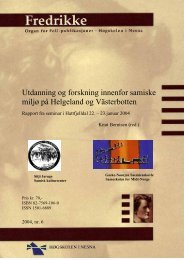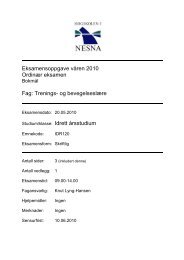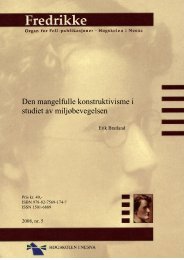ikt-basert norskundervisning i utlandet - Høgskolen i Nesna
ikt-basert norskundervisning i utlandet - Høgskolen i Nesna
ikt-basert norskundervisning i utlandet - Høgskolen i Nesna
Create successful ePaper yourself
Turn your PDF publications into a flip-book with our unique Google optimized e-Paper software.
Internet – the Space of Dialogue<br />
Ugnius Mikucionis<br />
Vilnius University, Vilnius, Lithuania<br />
(Ugnius Mikucionis is also employed at Vytautas Magnus University, Kaunas, Lithuania)<br />
E-mail: umikucionis@takas.lt, umikucionis@gmail.com<br />
34<br />
SUMMARY: Internet provides students and lecturers with a better possibility for reciprocal<br />
communication (interaction), allows them to contact their colleagues from abroad in a quick<br />
and cheap way, it also makes it easier to present the learning material (e. g. handouts) and to<br />
share all kinds of information (transaction); if used creatively, it might also contribute in<br />
encouraging students to be active, engaged and conscious about what they are learning, and<br />
why.<br />
One of the types of information, which can be shared through the internet, is interactive online<br />
exercises. On-line exercises are nowadays generally easily accessible for the students and<br />
contribute in making the process of learning a foreign language more interesting and<br />
fascinating. The benefits of on-line exercises are obvious if students have free-of-charge<br />
internet-access either at university or at home, and if they like to solve exercises individually.<br />
One cannot however ignore the importance of group work and the traditional classroomlectures<br />
while studying a living, natural language, such as Modern Norwegian.<br />
It is impossible to overestimate the value and importance of bilingual target language – native<br />
language dictionaries. There may be many misunderstandings and annoying blunders if one<br />
uses a third language as an “intermediary” translating between one's native language and the<br />
language one is studying (the so-called “target language”). Therefore we mean that the<br />
development of a Norwegian-Lithuanian dictionary software has been of great importance;<br />
this software is already being used by students at both Lithuanian universities where the<br />
Norwegian language is taught, namely, Vilnius University and Vytautas Magnus University<br />
in Kaunas.<br />
This final report consists of three main parts:<br />
• The first part, “Internet – the Space of Dialogue” deals mostly with theoretical issues in<br />
connection with communication through the internet and with our experience about such<br />
communication in the process of teaching of the Norwegian language.<br />
• The second part, “Who Likes Hot Potatoes?”, deals with JavaScript-based online interactive<br />
exercises we are creating for our students.<br />
• The third part, “Trollord, or What Is the Difference between a Casserole and Hashish”, tells<br />
about the ambitious project of creating of Norwegian-Lithuanian dictionary software for<br />
Windows.<br />
Internet the Space of Dialogue<br />
One usually talks about two main types of communication through the internet: synchronous<br />
and asynchronous. “Synchronous” means that all the participants are on-line at the same time,<br />
and the communication goes on in real time (as in different kinds of chatting, instant<br />
messaging or voice software, as MSN Messenger, ICQ or Skype).<br />
“Asynchronous” means that the participants may go on-line at different moments of time, and<br />
communicate by leaving messages to each other, so that it is possible to read and answer to<br />
the messages when it suites best each and every of the participants.<br />
Fredrikke nr. 11, 2005<br />
Organ for FoU-publikasjoner – <strong>Høgskolen</strong> i <strong>Nesna</strong>


